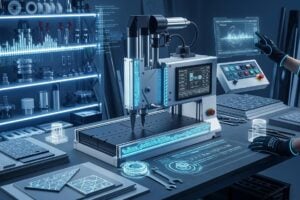Press Brake are widely used in industrial production, and their malfunctions may affect processing accuracy and production efficiency. The following are the common problems, causes, and solutions for CNC press brakes. The technical engineer of KRRASS for press brakes will conduct a detailed analysis from the aspects of machinery, electricity, hydraulic systems, and operations, and teach you how to solve these problems.
Table of Contents
1.Mechanical Aspects of Press Brake
1.1Decline in the Accuracy of the Press Brake Slide
- Causes:
- Wear on the guide rails or slide, insufficient lubrication, leading to increased frictional resistance.
- Loosening or damage of mechanical components (such as lead screws and nuts), resulting in displacement deviation.
- Asymmetrical installation of the mold, causing uneven stress on the slide.
- Solutions:
- Check the guide rail lubrication system, replenish or replace the lubricating oil, and clean the impurities on the guide rail surface.
- Tighten the connecting components such as lead screws and nuts, and replace the severely worn parts.
- Reinstall the mold to ensure left-right symmetry, and calibrate it with a level gauge.
1.2Excessive Deviation in the Bending Angle of the Press Brake
- Causes:
- Wear or improper installation of the mold, leading to the offset of the bending fulcrum.
- Error in the parallelism of the slide, or deformation of the worktable surface.
- Incorrect setting of CNC system parameters (such as pressure and stroke).
- Solutions:
- Replace the worn mold, readjust the mold installation position, and calibrate it with a protractor.
- Detect the parallelism of the slide, adjust the guide rail clearance, or replace the worktable surface.
- Reset the system parameters, conduct an empty machine trial run to calibrate the angle (which can be adjusted by trial-bending the template).
1.3Premature or Abnormal Wear of the Press Brake Mold
- Causes:
- Mismatch between the workpiece material and the mold hardness (such as using ordinary molds to process high-strength plates).
- Excessive bending pressure exceeding the mold’s bearing capacity.
- Misalignment during mold installation, causing localized stress concentration.
- Solutions:
- Select a mold with appropriate hardness according to the plate material (such as tungsten steel molds for high-strength steel).
- Adjust the system pressure parameters to avoid overloading (refer to the recommended values in the equipment manual).
- Use positioning pins or reference blocks during mold installation to ensure alignment between the upper and lower molds.
2.Hydraulic System Aspects of CNC Press Brakes
2.1Insufficient Pressure in the Press Brake
- Causes:
- Insufficient hydraulic oil, oil contamination, or reduced viscosity, leading to poor oil suction by the oil pump.
- Wear of the oil pump and aging of seals, causing hydraulic oil leakage.
- Malfunction of the relief valve (such as a stuck valve core), preventing pressure maintenance.
- Solutions:
- Check the oil level, replenish or replace the hydraulic oil (it is recommended to use anti-wear hydraulic oil and filter it regularly).
- Disassemble the oil pump, replace the worn components or seals, and check for leaks at the oil circuit interfaces.
- Clean the relief valve core and adjust the pressure setting value (professional operation is required).
2.2Abnormal Noise in the Press Brake Hydraulic System
- Causes:
- Too low oil level in the oil tank, air intake by the oil pump, or air bubbles in the oil circuit.
- Wear of the hydraulic pump bearings or resonance of the pipeline.
- Frequent actions of the directional valve, generating impact noise.
- Solutions:
- Replenish the hydraulic oil, check for air leakage in the suction pipe, and start the equipment to run idly to expel air.
- Replace the oil pump bearings, reinforce the pipeline to avoid resonance (shock-absorbing pads can be installed).
- Adjust the buffer parameters of the directional valve to reduce action shocks.
3.Electrical System Aspects of CNC Press Brakes
3.1Alarm in the CNC System of the Press Brake (such as overtravel, communication failure)
- Causes:
- Axis movement exceeding the limit switch range, triggering an overtravel alarm.
- Loose communication cable between the controller and the driver, or poor contact at the interface.
- System software malfunction (such as program errors, parameter loss).
- Solutions:
- Manually move the axis in the opposite direction to release the limit, and check if the limit switch is damaged.
- Re-plug the communication cable, use a multimeter to detect the continuity of the circuit, and replace the interface module.
- Restart the system, load the backup parameters, and contact the manufacturer to reinstall the system if the software crashes.
3.2Servo Motor of the Press Brake Fails to Run or Vibrates Abnormally
- Causes:
- Driver malfunction (such as damage to the power module, incorrect parameter setting).
- Encoder malfunction or poor contact of the connecting cable, leading to abnormal position feedback.
- Motor overload, or mechanical jamming causing excessive load.
- Solutions:
- Check the driver indicator lights, replace the damaged modules, and reset the motor parameters (such as pulse frequency, gain).
- Detect the encoder cable, replace the encoder or clean the encoder gear.
- Eliminate mechanical jamming, check the motor heat dissipation situation, and avoid overloading.
4.Operation and Process Issues of CNC Press Brakes
4.1Large Springback of the Workpiece after Bending
- Causes:
- Failure to consider the springback coefficient of the plate material (such as stainless steel and aluminum alloy having higher springback rates).
- Insufficient bending pressure, or excessive mold fillet radius.
- Failure to compensate for the springback amount in the bending angle setting.
- Solutions:
- Query the springback coefficient according to the plate material, and adjust the bending angle (for example, if the target is 90°, preset 88°~89°).
- Increase the bending pressure, replace the mold with a smaller fillet (which needs to match the plate thickness).
- Input the springback compensation parameters into the CNC system, and optimize the compensation value through trial bending.
4.2Scratches or Indentations on the Surface of the Workpiece
- Causes:
- Rough or burrs on the mold surface, not cleaned in time.
- Misalignment during plate placement, causing sliding friction.
- Insufficient pressure of the material holding cylinder, resulting in displacement of the plate during bending.
- Solutions:
- Polish the mold surface, apply anti-rust oil, and regularly clean the iron filings inside the mold.
- Use positioning baffles to fix the plate, ensuring accurate feeding.
- Adjust the pressure of the material holding cylinder (refer to the process requirements, generally 10%~15% of the bending pressure).
5.Preventive Measures and Daily Maintenance of CNC Press Brakes
- Regular Maintenance of the Press Brake:
- Check the lubrication system and hydraulic oil level weekly, replace the filter element monthly, and replace the hydraulic oil annually.
- Regularly clean the guide rails and lead screws, and apply special lubricating grease.
- Operation Specifications for the Press Brake:
- Strictly set the parameters according to the manual, and avoid overloading processing (such as exceeding the maximum bending length and thickness of the equipment).
- Conduct an empty machine trial run after installing a new mold, and start processing after confirming no abnormal noise.
- Parameter Backup for the Press Brake:
Regularly back up the CNC system parameters to avoid data loss due to power outages or misoperations.
The faults of CNC press brakes mostly originate from mechanical wear, hydraulic leakage, electrical abnormalities, and improper operation. When solving problems, follow the principle of “mechanical first, then electrical; hydraulic first, then system” to gradually troubleshoot the fault points. If system parameter adjustment or component replacement is involved, it is recommended to be operated by professional technicians to avoid expanding the fault due to misoperation. Through standardized maintenance and process optimization, the failure rate can be effectively reduced, and the service life of the equipment can be extended.





